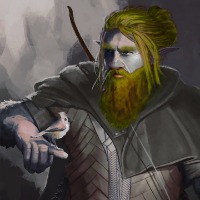
LINK TO SCRIPT: HERE I'm back. Here's a nice, simple little script I put together for my players that shows the current positions of the planets in Realmspace, according to the Spelljammer campaign guide (Dungeons and Dragons). In short, the planets on the map "rotate" at different speeds based on their orbital speed. Time is elapsed with a chat command. You can make your map however you want with the basic requirements that each "planet" is a circular orbit (sorry, elliptical orbits would be far too complicated for me to bother with right now). They can be off-center though! It's your universe, after all. My planets all rotate with the sun in the center, like so. Each planet and circle are a separate graphic. There are 10 graphics total on this map, if you include the sun and the spaceship. Here's an example graphic for the planet Anadia, which has a white circle around a transparent center, and the planet is on that circle at the bottom of the graphic: Then, put "isPlanet" (without quotes) in each graphic's GMnotes (there should be 8 planets total, per the campaign guide). Finally, put the name of each planet in the "name" field for the graphic, like so: The names of each planet are formatted exactly as following (case sensitive): Anadia Coliar Toril Karpri Chandos Glyth Garden HCatha Of course, should you desire, it shouldn't be too hard to change these in the script, which is small and easy to figure out. You can change the names, the amount of planets and the math for their rotations which is (days in a year/360). Rotate the planets for their initial positioning by rotating the graphics as normal. Once that's done, there's only one command: !protate [days] Where "days" is how many days should elapse (you can even use partial days, example 0.65 , or 340.2345) . For example, since my grids in the map above are 10 million miles each, that equates to one day of travel. So every time my players move their ship, I just click the handy macro I made (!protate 1) and enjoy my players awe as the planets rotate in tandem with their movements. I'm sure you can make this script more complicated by tying the elapsed time with the total distance covered by a token, but I prefer to do it manually. There is a single variable: clockwise. This changes the direction of rotation. Default is false. Enjoy. LINK TO SCRIPT: HERE


